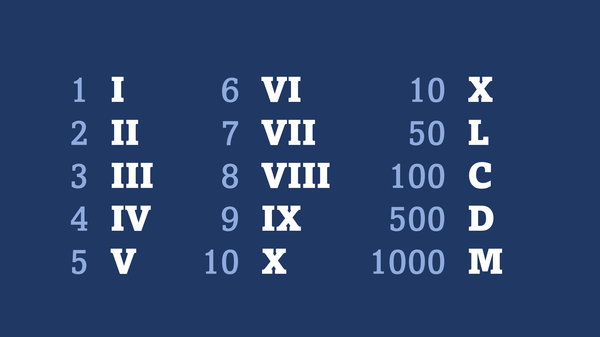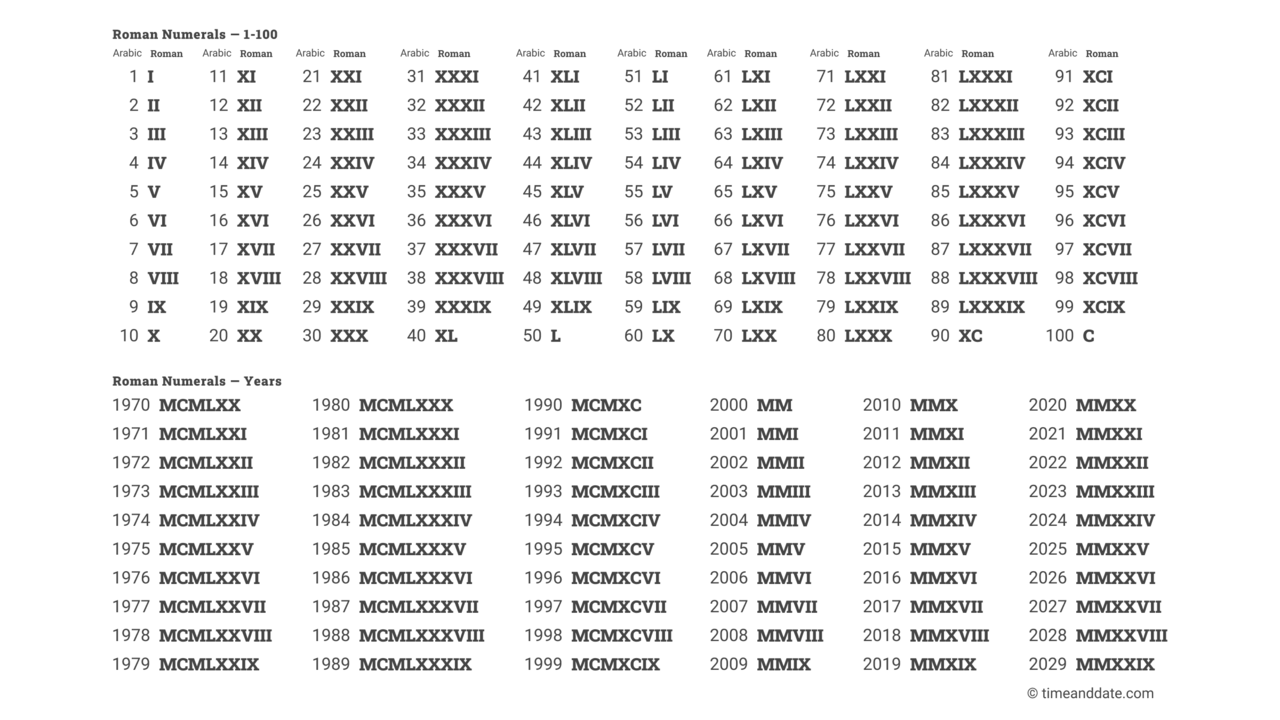How to Write and Count Roman Numerals
Roman numerals consist of the letters I, V, X, L, C, D, and M, representing 1, 5, 10, 50, 100, 500, and 1000.

Roman numerals are based on the Roman alphabet.
© timeanddate.com
What Are Roman Numerals?
Roman numerals are a system for writing numbers using seven letters from the Roman alphabet: Ⅰ, Ⅴ, Ⅹ, Ⅼ, Ⅽ, Ⅾ, and Ⅿ. They represent the numbers one, five, ten, fifty, one hundred, five hundred, and one thousand.
The system was developed in ancient Rome and dominated the West for at least 1500 years. Roman numerals were replaced by the Hindu-Arabic numeral system (0-9) in the 14th century. The Eastern system was better suited for calculating fractions, larger numbers, and more complicated computations.
Convert any number into Roman numerals
How Do Roman Numerals Work?
To write any number in Roman numerals, combine the Roman letters Ⅰ (1), Ⅴ (5), Ⅹ (10), Ⅼ (50), Ⅽ (100), Ⅾ (500), and Ⅿ (1000). Start with the highest number. For example, 2025 in Roman numerals is ⅯⅯⅩⅩⅤ.
- ⅯⅯ means 1000 + 1000
- ⅩⅩ means 10 + 10
- Ⅴ means 5
- Together it is 2000 + 20 + 5 = 2025
Roman numerals are generally written from high to low, and the values are added. You can add a maximum of three identical numerals this way. The number three is written Ⅲ = 1 + 1 + 1.
The number four is not written ⅠⅠⅠⅠ since this would break the rule above. Instead, four is written Ⅳ (5 minus 1), using subtraction. To subtract a number, you place a lower number in front of a higher number. Following the rules of addition and subtraction, eight is written Ⅷ (5 plus 3), while nine is written Ⅸ (10 minus 1).
The rules of subtraction for Roman numerals are quite strict: You can only subtract with Ⅰ (1), Ⅹ (10), and Ⅽ (100). And you can only subtract from the next two higher values in the sequence. This leaves only six valid subtractions:
- Ⅳ (4) and Ⅸ (9)
- ⅩⅬ (40) and ⅩⅭ (90)
- ⅭⅮ (400) and ⅭⅯ (900)
You can subtract Ⅰ from Ⅴ (5) and Ⅹ (10) but never from Ⅽ (100). To write 99, you have to subtract 10 from 100 (ⅩⅭ) and add the subtraction of 1 from 10 (Ⅸ), creating ⅩⅭⅨ.
Roman Numerals Chart (Roman vs. Arabic)


Roman Numerals — Simple Chart
Do Roman Numerals Have Zero?
There is no letter for zero in the Roman numeral system. Only after the fall of Rome, around the year 500 CE, did scholars start to use the letter N to mean nulla or “nothing.” The ancient Romans did not need a zero.
The Roman system is additive: Every symbol is always the same value, and all are added together. Ⅰ is always one, and Ⅿ is always a thousand. Our modern system is positional: The symbol’s position defines its value. 1 is one, yet the same symbol followed by three zeros suddenly becomes a different number: 1000 is not one but one thousand.
Where Did Roman Numerals Come From?
Thousands of years ago, shepherds cut lines into sticks to count their animals. The sticks were usually made from bone or wood and were called tally, from the Latin word talea (wooden stick). Counting by cutting tallies or drawing lines for each count is called tally-marking.

Tally sticks have been used for thousands of years.
By Sandstein, CC BY 3.0
The ancient Romans adopted this counting method from the Etruscans, who lived on the Italian Peninsula before the Romans. The Etruscans had a system where one count was one cut (I), every fifth count was a double cut (𐌡), and every tenth count became a cross-cut (X).
The Romans adopted the Etruscan tally-mark system and, over time, changed the symbols into what is known today as the Roman numeral system. One example of this change is the Etruscan symbol for 5 (𐌡) that became the Roman letter Ⅴ.
Roman Numerals In Use Today
We still use Roman numerals today: Classic watches and clock faces use Roman numerals to mark the numbers from one to twelve (Ⅻ); chapters in books and acts in plays are still often counted with Roman letters (Act Ⅳ), as are the names of kings, queens, popes, and emperors (Queen Elizabeth Ⅱ).
When people want to remember a particular event, many get a tattoo with Roman numerals spelling out a special date—birthdays, wedding dates, and other commemorations.
Convert your date into Roman numerals
Probably the most popular use of Roman numerals, at least in the USA, is the Super Bowl. The annual championship game of the National Football League (NFL) has been using Roman numerals to count the years since 1969 (Super Bowl Ⅲ). The next Super Bowl will be held on February 8, 2026, and will be known as Super Bowl ⅬⅩ (Super Bowl 60).

Classic watches and clocks often use Roman numerals.
© iStockphoto.com/123ducu
Are XL and XXX Roman Numbers?
If you see the letters XL or XXL in a piece of clothing, they do not refer to Roman numerals (although XL is the Roman numeral for 40). Instead, they mean Extra Large and Extra Extra Large.
XXX is often used to label pornographic content or content with extreme violence. The label has nothing to do with Roman numerals. The British Board of Film Classification introduced a category of films for viewers over 16 years in 1951. This category was labeled X for extremely graphic content.
Seventeen years later, in 1968, the Motion Picture Association of America (MPAA) introduced a similar label. The MPAA used X for films containing extreme violence, sexual content, and graphic language. Because the X rating was not trademarked, anyone could sell their movie as “X-rated.”
When pornographic movies became popular in the 1970s, many studios and publishers used the label as a marketing tool. Filmmakers would advertise their movies as X, XX, or even XXX, to appear more extreme.